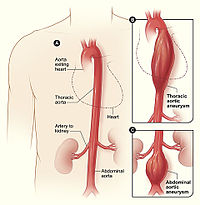
Photo from wikipedia
To date, emergent total endovascular aortic arch repair has not been described in the literature. We present a 67-year-old female with a poorly differentiated posterior mediastinal sarcoma. Imaging obtained was… Click to show full abstract
To date, emergent total endovascular aortic arch repair has not been described in the literature. We present a 67-year-old female with a poorly differentiated posterior mediastinal sarcoma. Imaging obtained was concerning for intravascular extension of the tumor into the thoracic aorta. While awaiting radiation therapy, the patient complained of worsening chest and arm pain, vital signs demonstrating tachypnea and hypoxia. Subsequent imaging revealed an increase in vascular erosion, concerning for a contained rupture, with complete obliteration of the left mainstem bronchus. The patient was emergently taken for percutaneous endovascular repair of her aortic arch. A three-vessel physician modified fenestrated graft was created and deployed with concurrent stenting of the innominate, left carotid, and left subclavian arteries. Interval computed tomography angiography revealed patency in all stented vessels, with no endoleak and no evidence of pseudoaneurysm. The patient was able to undergo chemotherapy with favorable decrease in tumor burden. Total endovascular aortic arch repair, when planned carefully, is an attractive option in high-risk patients who are otherwise not ideally suited for open total arch replacement.
Journal Title: Vascular and endovascular surgery
Year Published: 2023
Link to full text (if available)
Share on Social Media: Sign Up to like & get
recommendations!